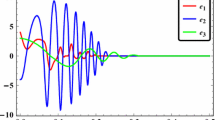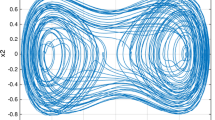Abstract
Synchronization of chaotic systems is considered to be a common engineering problem. However, the proposed laws of synchronization control do not always provide robustness toward the parametric perturbations. The purpose of this article is to show the use of synergy-cybernetic approach for the construction of robust law for Arneodo chaotic systems synchronization. As the main method of design of robust control, the method of design of control with forced sliding mode of the synergetic control theory is considered. To illustrate the effectiveness of the proposed law, in this article it is compared with the classical sliding mode control and adaptive backstepping. The distinctive features of suggested robust control law are the more good compensation of parametric perturbations (better performance indexes—the root-mean-square error (RMSE), average absolute value (AVG) of error) without designing perturbation observers, the ability to exclude the chattering effect, less energy consuming and a simpler analysis of the stability of a closed-loop system. The study of the proposed control law and the change of its parameters and the place of parametric perturbation’s application is carried out. It is possible to significantly reduce the synchronization error and RMSE, as well as AVG of error by reducing some parameters, but that leads to an increase in control signal amplitude. The place of application of parametric disturbances (slave or master system) has no effect on the RMSE and AVG of error. Offered approach will allow a new consideration for the design of robust control laws for chaotic systems, taking into account the ideas of directed self-organization and robust control. It can be used for synchronization other chaotic systems.














Similar content being viewed by others
Data availability
The author declares that all data supporting the findings of this study are available within the article. The model, control laws and their parameters are fully presented in the article. It is not difficult to perform their modeling in Matlab.
Also data were generated in article are available on request from the author.
References
Pecora, L., Carroll, T.: Synchronization in chaotic systems. Phys. Rev. Lett. 64, 821 (1990). https://doi.org/10.1103/PhysRevLett.64.821
Boccaletti, S., Kurths, J., Osipov, G., Valladares, D., Zhou, C.: The synchronization of chaotic systems. Phys. Rep. 366, 1 (2002). https://doi.org/10.1016/S0370-1573(02)00137-0
Agiza, H., Yassen, M.: Synchronization of Rossler and Chen chaotic dynamical systems using active control. Phys. Lett. Sect. A General Atomic Solid State Phys. 278, 191 (2001). https://doi.org/10.1016/S0375-9601(00)00777-5
Arneodo, A., Coullet, P., Tresser, C.: Occurrence of strange attractors in three-dimensional Volterra equations. Phys. Lett. Sect. A 79(4), 259 (1980). https://doi.org/10.1016/0375-9601(80)90342-4
Sundarapandian, V.: In Global chaos synchronization of Arneodo chaotic system via backstepping controller design. ACM Int. Conf. Proc. Ser. (2012). https://doi.org/10.1145/2393216.2393217
Sundarapandian, V., Rasappan, S.: Hybrid synchronization of Arneodo and Rössler chaotic systems by active nonlinear control. In: Lecture Notes of the Institute for Computer Sciences, Social-Informatics and Telecommunications Engineering, LNICST, vol. 84(PART 1), p. 73 (2012). https://doi.org/10.1007/978-3-642-27299-8_8
Chen, H.K.: Global chaos synchronization of new chaotic systems via nonlinear control. Chaos Solitons Fractals 23, 1245 (2005). https://doi.org/10.1016/S0960-0779(04)00373-X
Feki, M.: An adaptive chaos synchronization scheme applied to secure communication. Chaos Solitons Fractals 18, 141 (2003). https://doi.org/10.1016/S0960-0779(02)00585-4
Tan, X., Zhang, J., Yang, Y.: Synchronizing chaotic systems using backstepping design. Chaos Solitons Fractals 16, 37 (2003). https://doi.org/10.1016/S0960-0779(02)00153-4
Kapitaniak, T.: Continuous control and synchronization in chaotic systems. Chaos Solitons Fractals 6, 237 (1995). https://doi.org/10.1016/0960-0779(95)80030-K
Cuomo, K., Oppenheim, A.: Circuit implementation of synchronized chaos with applications to communications. Phys. Rev. Lett. 71, 65 (1993). https://doi.org/10.1103/PhysRevLett.71.65
Kocarev, L., Parlitz, U.: General approach for chaotic synchronization with applications to communication. Phys. Rev. Lett. 74, 5028 (1995). https://doi.org/10.1103/PhysRevLett.74.5028
Rulkov, N., Sushchik, M., Tsimring, L., Abarbanel, H.: Generalized synchronization of chaos in directionally coupled chaotic systems. Phys. Rev. E 51, 980 (1995). https://doi.org/10.1103/PhysRevE.51.980
Bai, E.W., Lonngren, K.: Synchronization and control of chaotic systems. Chaos Solitons Fractals 10, 1571 (1999). https://doi.org/10.1016/S0960-0779(98)00204-5
Yau, H.T.: Design of adaptive sliding mode controller for chaos synchronization with uncertainties. Chaos Solitons Fractals 22, 341 (2004). https://doi.org/10.1016/j.chaos.2004.02.004
Lu, J.: Chaotic dynamics and synchronization of fractional-order Arneodo’s systems. Chaos Solitons Fractals 26, 1125 (2005). https://doi.org/10.1016/j.chaos.2005.02.023
Hua, C., Guan, X., Shi, P.: Adaptive feedback control for a class of chaotic systems. Chaos Solitons Fractals 23, 757 (2005). https://doi.org/10.1016/j.chaos.2004.05.042
Femat, R., Solís-Perales, G.: On the chaos synchronization phenomena. Phys. Lett. Sect. A General Atomic Solid State Phys. 262(1), 50 (1999). https://doi.org/10.1016/S0375-9601(99)00667-2
Zhang, R., Yang, S.: Adaptive synchronization of fractional-order chaotic systems via a single driving variable. Nonlinear Dyn. 66(4), 831 (2011). https://doi.org/10.1007/s11071-011-9944-2
Zhang, L., Yan, Y.: Robust synchronization of two different uncertain fractional-order chaotic systems via adaptive sliding mode control. Nonlinear Dyn. 76(3), 1761 (2014). https://doi.org/10.1007/s11071-014-1244-1
Chen, D., Zhang, R., Ma, X., Liu, S.: Chaotic synchronization and anti-synchronization for a novel class of multiple chaotic systems via a sliding mode control scheme. Nonlinear Dyn. 69(1–2), 35 (2012). https://doi.org/10.1007/s11071-011-0244-7
Yu, X., Zhihong, M.: Fast terminal sliding-mode control design for nonlinear dynamical systems. IEEE Trans. Circuits Syst. I Fundam. Theory Appl. 49, 261 (2002). https://doi.org/10.1109/81.983876
Laghrouche, S., Plestan, F., Glumineau, A.: Higher order sliding mode control based on integral sliding mode. Automatica 43, 531 (2007). https://doi.org/10.1016/j.automatica.2006.09.017
Konishi, K., Hirai, M., Kokame, H.: Sliding mode control for a class of chaotic systems. Phys. Lett. Sect. A 245(6), 511 (1998). https://doi.org/10.1016/S0375-9601(98)00439-3
Vaidyanathan, S., Volos, C.K., Pham, V.T.: Global chaos control of a novel nine-term chaotic system via sliding mode control. Stud. Comput. Intell. 576, 571 (2015). https://doi.org/10.1007/978-3-319-11173-5_21
Rodríguez, A., De León, J., Fridman, L.: Quasi-continuous high-order sliding-mode controllers for reduced-order chaos synchronization. Int. J. Non-Linear Mech. 43(9), 948 (2008). https://doi.org/10.1016/j.ijnonlinmec.2008.07.007
Ahmed, H., Salgado, I., Ríos, H.: Robust synchronization of master-slave chaotic systems using approximate model: An experimental study. ISA Trans. 73, 141 (2018). https://doi.org/10.1016/j.isatra.2018.01.009
Kolesnikov, A.: Introduction of synergetic control. In: Proceedings of the American Control Conference, pp. 3013–3016 (2014). https://doi.org/10.1109/ACC.2014.6859397
Kolesnikov, A., Veselov, G., Popov, A., Dougal, R. et al., Synergetic approach to the modeling of power electronic systems. In: IEEE Workshop on Computers in Power Electronics, pp. 259–262 (2000)
Santi, E., Monti, A., Li, D., Proddutur, K., Dougal, R.: Synergetic control for power electronics applications: a comparison with the sliding mode approach. J. Circuits Syst. Comput. 13(4), 737 (2004). https://doi.org/10.1142/S0218126604001520
Rastegar, S., Araújo, R., Sadati, J., Mendes, J.: A novel robust control scheme for LTV systems using output integral discrete-time synergetic control theory. Eur. J. Control 34, 39 (2017). https://doi.org/10.1016/j.ejcon.2016.12.006
Rebai, A., Guesmi, K., Hemici, B.: Adaptive fuzzy synergetic control for nonlinear hysteretic systems. Nonlinear Dyn. 86(3), 1445 (2016). https://doi.org/10.1007/s11071-016-3088-3
Ni, J., Liu, C., Liu, K., Pang, X.: Variable speed synergetic control for chaotic oscillation in power system. Nonlinear Dyn. 78(1), 681 (2014). https://doi.org/10.1007/s11071-014-1468-0
Kuz’menko, A.: Nonlinear adaptive control of a turbogenerator. J. Comput. Syst. Sci. Int. 47(1), 103 (2008). https://doi.org/10.1134/s1064230708010139
Bouchama, Z., Essounbouli, N., Harmas, M., Hamzaoui, A., Saoudi, K.: Reaching phase free adaptive fuzzy synergetic power system stabilizer. Int. J. Electr. Power Energy Syst. 77, 43 (2016). https://doi.org/10.1016/j.ijepes.2015.11.017
Kuz’menko, A., Sinitsyn, A., Mushenko, A.: The use of integral adaptation principle to increase the reliability of DFIG-Wind turbine power system. In: Proceedings of 2017 International Siberian Conference on Control and Communications, SIBCON-2017 (2017). https://doi.org/10.1109/SIBCON.2017.7998487
Kuz’menko, A.: Synchronous generator nonlinear excitation system: synergetic sliding mode control. In: Proceedings of 2015 International Siberian Conference on Control and Communications, SIBCON 2015 (2015). https://doi.org/10.1109/SIBCON.2015.7147112
Kuz’menko, A.: Synthesis of the sliding mode control law of synchronization of chaotic systems basing on sequential aggregate of invariant manifolds. In: Proceedings of 2019 3rd International Conference on Control in Technical Systems, CTS 2019, pp. 60–63 (2019). https://doi.org/10.1109/CTS48763.2019.8973371
Kolesnikov, A., Kuz’menko, A.: Forced sliding mode control: synergetic approach. In: Proceedings of 2020 2nd International Conference on Control Systems, Mathematical Modeling, Automation and Energy Efficiency, SUMMA 2020 , pp. 36–40. (2020). https://doi.org/10.1109/SUMMA50634.2020.9280620
Levant, A.: Chattering analysis. IEEE Trans. Autom. Control 55(6), 1380 (2010). https://doi.org/10.1109/TAC.2010.2041973
Arneodo, A., Coullet, P., Spiegel, E., Tresser, C.: Phys. D Nonlinear Phenom. 14(3), 327 (1985). https://doi.org/10.1016/0167-2789(85)90093-4
Liu, Y., Li, Z., Cai, X., Ye, Y.: Local stability and Hopf bifurcation analysis of the Arneodo’s system. Appl. Mech. Mater. 130–134, 2550 (2012). https://doi.org/10.4028/www.scientific.net/AMM.130-134.2550
Zambrano-Serrano, E., Anzo-Hernández, A.: A novel antimonotic hyperjerk system: analysis, synchronization and circuit design. Phys. D Nonlinear Phenom. (2021). https://doi.org/10.1016/j.physd.2021.132927
Kuz’menko, A.: Synthesis of synergetic sliding mode control law of synchronous generator basing on sequential aggregate of invariant manifolds. In: Proceedings of 2019 International Russian Automation Conference, RusAutoCon 2019 (2019). https://doi.org/10.1109/RUSAUTOCON.2019.8867666
Utkin, V., Guldner, J., Shi, J.: Sliding Mode Control in Electromechanical Systems. Sliding Mode Control in Electromechanical Systems, 2nd edn. CRC Press, Boca Raton (2009)
Author information
Authors and Affiliations
Corresponding author
Ethics declarations
Conflict of interest
The author declares that he have no conflict of interest. The author has no relevant financial or non-financial interests to disclose. No funding was received to assist with the preparation of this manuscript.
Additional information
Publisher's Note
Springer Nature remains neutral with regard to jurisdictional claims in published maps and institutional affiliations.
Appendices
Appendix A
The basic method of the SCT is the method of analytical designing aggregated regulators [28, 29]. Let us consider its stages described in [30].
Suppose the system to be controlled is described by a set of nonlinear differential equations in the form
where x is the state vector, u is the control input vector and t is time.
Let us start by defining a macro-variable as a function of the state variables:
The control will force the system to operate on the manifold \(\psi =0\). The designer can select the characteristics of this macro-variable according to the control specifications (e.g., limitation of the control output, etc.). In a trivial case, the macro-variable can be a simple linear combination of the state variables. In a nontrivial case, it is complex nonlinear function.
The same process can be repeated, defining as many macro-variables as there are control channels.
The desired dynamic evolution of the macro-variable is
where T is the design parameter specifying the convergence speed to the manifold specified by the macro-variable. The chain rule of differentiation (A.2) gives
Combining (A.1), (A.3), and (A.4), we obtain
The Eq. (A.5) is finally used to synthesize the control law u : we express it from this equation.
To summarize, each manifold introduces a new constraint on the state space domain and reduces the order of the system, improving the global stability.
The procedure summarized here can be easily implemented as a computer program for automatic synthesis of the control law.
Appendix B
Let us introduce derivative for module function:
According (B.6), we find derivative of \(\psi _1\) (5):
and derivative of \(s_1\) (6):
And now we can substitute (B.7) and (B.8) into (8) for \(k=1\):
To simplify, we divide left part by \(T_1\) and multiply by \({\text {sign}}(s_1)\):
We substitute \(\dot{x}_j(t)\) and \(\dot{x}_n(t)\) from (4) in (B.9)
Rights and permissions
About this article
Cite this article
Kuz’menko, A.A. Forced sliding mode control for chaotic systems synchronization. Nonlinear Dyn 109, 1763–1775 (2022). https://doi.org/10.1007/s11071-022-07552-x
Received:
Accepted:
Published:
Issue Date:
DOI: https://doi.org/10.1007/s11071-022-07552-x
Keywords
- Chaos synchronization
- Robust control
- Synergetic control theory
- Arneodo chaotic system
- Sliding mode control
- Forced sliding mode




